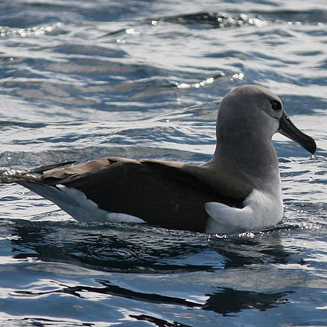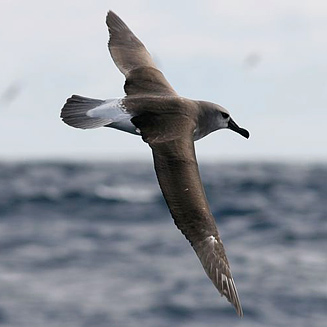|
Thalassarche chrysostoma
(Grey-headed albatross)
[= Diomedea chrysostoma]
Gryskopalbatros [Afrikaans]; Gryskopmalmok [Afrikaans];
Grijskopalbatros [Dutch]; Albatros à tête grise [French];
Graukopfalbatroß [German]; Albatroz-de-cabeça-cinzenta [Portuguese]
Life
> Eukaryotes >
Opisthokonta
> Metazoa (animals) >
Bilateria >
Deuterostomia > Chordata >
Craniata > Vertebrata (vertebrates) > Gnathostomata (jawed
vertebrates) > Teleostomi (teleost fish) > Osteichthyes (bony fish) > Class:
Sarcopterygii (lobe-finned
fish) > Stegocephalia (terrestrial
vertebrates) > Tetrapoda
(four-legged vertebrates) > Reptiliomorpha > Amniota >
Reptilia (reptiles) >
Romeriida > Diapsida > Archosauromorpha > Archosauria >
Dinosauria
(dinosaurs) > Saurischia > Theropoda (bipedal predatory dinosaurs) >
Coelurosauria > Maniraptora > Aves
(birds) > Order: Ciconiiformes
> Family: Diomedeidae
 |
 |
| Grey-headed albatross, offshore from
Cape Town, South Africa. [photo Trevor Hardaker ©] |
Grey-headed albatross, offshore from Cape Town,
South Africa. [photo Trevor Hardaker ©] |
Distribution and habitat
Breeds on sub-Antarctic islands, dispersing across the
southern oceans but generally staying below 40° South. Juveniles and immatures
may range further north, including in southern African Waters off the southern
and western coast of South Africa.
Movements and migrations
Adults return to breed at their colonies in
September, so that their chicks can fledge by May - it is present in
southern Africa from June-September.
Food
Its diet in southern African is largely unknown, but
probably consists of mainly offal and discards from fishing vessels.
Threats
Vulnerable due to continuous population decreases at
a number of its colonies, linked to mortalities on longlines.
References
-
Hockey PAR, Dean WRJ and Ryan PG 2005. Roberts
- Birds of southern Africa, VIIth ed. The Trustees of the John Voelcker
Bird Book Fund, Cape Town.
|
